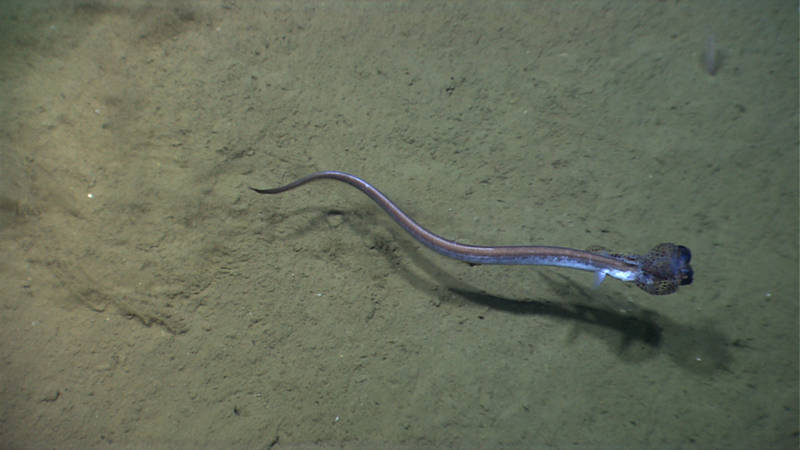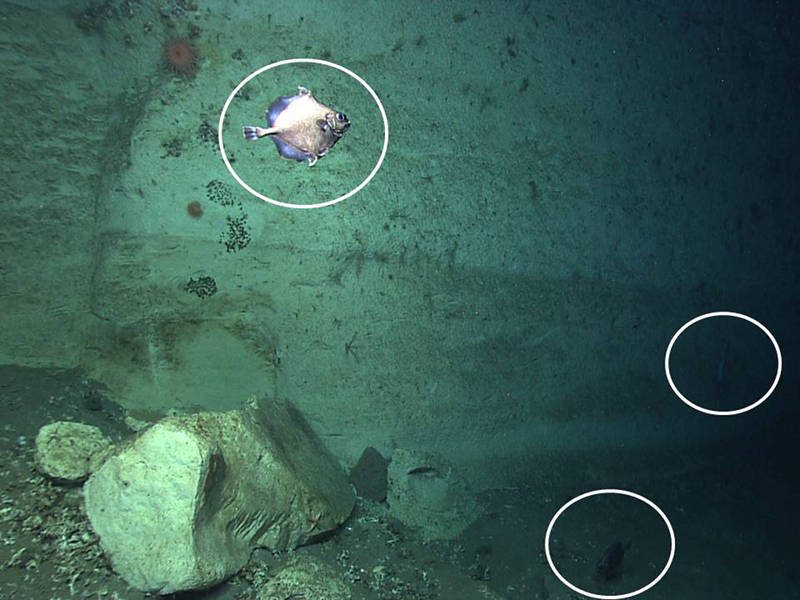
By Peter Auster
Emily Duwan - Mystic Aquarium and University of Connecticut
September 28, 2014
An anglerfish, of which we saw one, and of only nine species and 21 individuals we observed during our dive on Atlantis II (compared to 15 species and 65 individuals observed at the minor canyon east of Veatch). Video courtesy of NOAA Okeanos Explorer Program, Our Deepwater Backyard: Exploring Atlantic Canyons and Seamounts. Download larger version (mp4, 9.7 MB)
When comparing the fish fauna between different submarine canyons, as well as between canyons and seamounts, there are obvious differences in species diversity and abundance.
In this part of the world, we generally encounter many more individuals per dive in the canyons than on seamounts, but the pattern of accumulating new species as we add more individuals to our list is the same. For example, we might find 10 species for every 100 fishes we encounter. It might take five hours of search time in canyons to find this number of individuals and species, while 20 or more hours on the New England Seamounts, due to differences in density.
Yesterday, our dive at the Atlantis II Seamount Complex produced a total of 20 individual fishes of nine taxonomic groups (some could be identified to species but others only to higher taxonomic levels like genera or family). That is in contrast to a dive of about the same number of hours in a minor canyon east of Veatch Canyon that encountered 65 individuals of 15 taxa.

This image of a cutthroat eel with captured squid nicely shows predator prey interactions in the deep sea. Image courtesy of the NOAA Office of Ocean Exploration and Research, Exploring Atlantic Canyons and Seamounts 2014. Download larger version (jpg, 1.3 MB).
Some of these differences in the fish fauna are due to differences in the availability of prey and shelter. Zooplankton prey are delivered by currents that vary within and between canyons and seamounts. Canyons are much more productive due to the direct links between continental shelf and slope waters. In contrast, the seamounts occur mostly under low-productivity tropical and Gulf Stream waters.
Prey that live on and in the seafloor vary in abundance due to differences in seafloor sediment types (mud, sand, rock) mediated by geologic processes past and present. The interactions between water flow and sediment type (and how bottom types are spatially arranged – such as flat sand versus sand waves crests or basalt pavements versus vertical cliffs) mediate where and when the diversity of fish occurs. For example, exploratory dives here in Northwest Atlantic canyons and seamounts found that some deep-sea fish species are generalists occurring in all habitats, others are specialists in either soft sediment or hard-bottom habitats, and others primarily occurred along ecotones (where two habitats meet).
On seamounts, ecotone habitats are extensive and form where depressions filled with sediments meet basalt pavements and cliffs. Here zooplankton that drift over the seamount at night and are trapped when they migrate downwards during the day are trapped along the rocky edges in these ecotones as they scurry to find a pathway to dark and deeper water. Fish that feed on these animals and have head shapes and jaws that allow efficient foraging in the small crevices that commonly occur in these habitats benefit from the daily accumulation of prey.
There also are differences in the behavior of the same species of fish between canyons and seamounts. For example, cutthroat eels and halosaurs often exhibit a "sit and wait" feeding tactic in canyons where they maintain their position above a burrow or alongside a rock and ambush prey as it emerges or drifts by. In contrast, on seamounts where productivity is much lower, they exhibit more energetically intensive foraging tactics by actively searching for prey within the landscape or by hovering and drifting over the seafloor, ready to ambush prey they encounter.

Here you can see three oreo fish (Neocyttus) that Deep Discoverer encountered during Dive 04 in a minor canyon east of Veatch. Download larger version (jpg, 236 KB).
Based on exploration cruises over the past 10 years, we are reforming our view of the diversity of fish communities in our deep-sea backyard. In addition to developing a better understanding of how fish make a living in the diverse ecological settings in the deep sea, more fundamentally, we are still defining who all of the players (species) are in this ecosystem.
For example, we originally thought there were several species of deep-sea fishes in the Northwest Atlantic region that occurred only on seamounts but did not occur in submarine canyons or along the continental margin. Before these expeditions began, we had originally thought false boarfish, a species in the family of fishes commonly known as oreos (for the family Oreosomatidae, not for the cookie of the same name), occurred only in the eastern Atlantic. Dives with submersibles and remotely operated vehicles (ROVs) from 2003-2005 revealed this species in fact did occur on the upper crests and peaks of the New England and Corner Rise seamounts in the western North Atlantic, appearing to use these major geologic features as stepping stones to the west.
These had never before been sampled by the thousands of trawl net surveys along the North American continental margin over many decades. However, a single individual had been observed once in Lydonia Canyon from the submersible Alvin in the 1970s. We assumed there was never a critical number of individuals to successfully colonize the canyon or the region. Then a series of ROV dives during 2007 off Atlantic Canada revealed this species occurred along the continental margin in complex geologic and deep coral habitats.
Our dives in submarine canyons last year and over the past week have revealed this species in fact occurs in some numbers in the deep waters of many of our own submarine canyons. A modern discovery of new deep-sea wildlife right in one of the most well-studied parts of the global ocean. Certainly there is more to come.